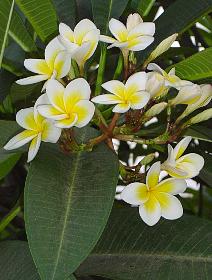Frangipani, Plumeria Alba
 Etymology: the botanical genus is named Plumeria in honor of the botanist Charles Plumier (1646-1704). Its vernacular name, Frangipanier, comes from Italian Frangipani which fabricated a perfume very appreciated in XIIth century: the four centuries later European passengers discovered this tree in the Caribbean in the similar perfume. Etymology: the botanical genus is named Plumeria in honor of the botanist Charles Plumier (1646-1704). Its vernacular name, Frangipanier, comes from Italian Frangipani which fabricated a perfume very appreciated in XIIth century: the four centuries later European passengers discovered this tree in the Caribbean in the similar perfume.
Origin: Tropical America, Caribbean. It becomes acclimated very well under tropics and particularly in Extreme East where it is often planted near temples and in graveyards.
Habitat: tropical countries.
Height: 10 m tall. The frangipanier is part of the nicest tropical trees with flowers of the American continent.
Trunk: often wiry with short and thick branches and fleshy stems lactescens introducing big scars.
Foliage deciduous. Leaves alternate, oblong, lanceolate, green shiny on the top, possible attain 30 cm in length. The back is trimmed with a down tomentose. Fall of leaves at the beginning of the period of drought.
Flowers: insulated, flower-shaped patelliform of 2,5 cm in diameter, of red colour (PlumeriaRubra), pink, crimson, white or yellow, appearing at the beginning of the wet season. They exude a strong nice fragrance which reminds that of the jasmine.
Fruits: Almost cylindrical, narrow, tough Follicles and possible attain 25 cm in length.
Uses: decorative, sweet-scented shrub. The sap is toxic and sometimes used to burn warts. Flowers are edible. Pastries and jam were made.
Asiatic legend: In Oriental Asia Frangipanier has reputation to be undying because It continues giving flowers and leaves even though It was torn off. Indeed, it transplants by boutture.
|